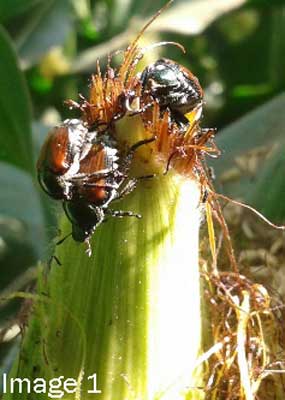
- Both Japanese beetle adults and larvae damage crops and other plants.
- Japanese beetles have an asynchronous life cycle and damage may occur over an extended period of time.
- Beetles usually begin emerging and feeding in mid-June. Grubs hatch from eggs and begin feeding shortly thereafter.
- Japanese beetles may cause economic damage to corn silks and soybean foliage.
Background
Japanese beetles (Popillia japonica) are one of the insect pests that causes damage in both the larval (grub) stage, and as adults (beetles). The pest has a wide host range of over 200 plant species that includes corn and soybeans, but also many vegetable, fruit tree, ornamental, and specialty plantings. Plants in the rose family are a favorite food of Japanese beetles. Even full grown shade trees, like linden, pin oak, maple, and others are targets for Japanese beetle feeding. Turfgrass is also a common host for the Japanese beetle grubs.
Development and Life Cycle
Japanese beetle adult emergence is less synchronous than that of other annual white grub species. What this means is that, across much of the central Corn Belt, beetle emergence usually starts by mid-June but continues over several weeks. Beetle emergence usually peaks about the second week of July, or later in northern areas. High numbers of beetles will continue to show up at least through the end of July. Meanwhile, beetles mate and lay eggs over a period of several weeks. As a result, damage from both grubs and beetles is extended over a long period of time.
Individual Japanese beetles live for an average of 4 to 6 weeks. Staggered emergence of beetles guarantees that feeding and egg laying activity will occur over 8 weeks or more, with peak egg laying roughly coinciding with peak beetle emergence. Beetles are sometimes observed into September in our area. Japanese beetles are promiscuous, mating several times, with this activity punctuated by periods of feeding and egg laying. Female beetles lay a total of 40 to 60 eggs, batched out over several egg laying events.
Female beetles enter the soil to lay eggs and may stay there for several days. They will usually lay eggs near their feeding sites, but may move to nearby fields or turf areas if better soil conditions are available. This is one of the reasons that beetle populations and subsequent grub feeding are not always in the same areas or fields. Moist (irrigated) turf or grassy areas are preferred for egg laying, but cultivated soils are also often chosen for egg laying, especially if such soils are moist and cool. Soils that are hard, crusted, free of vegetation, hot, or dry, are less desirable for egg laying and are avoided in favor of more desirable sites.
Japanese beetle grubs go through 3 developmental stages, or instars. Second and third instar grubs are the ones that most often overwinter, but even first instar grubs can successfully overwinter if they have had a chance to build up food reserves prior to the onset of cold weather. Japanese beetle grubs feed on roots and decaying vegetation in the top 2 to 4 inches of the soil until soil temperatures drop to about 60°F. At that time they often move slightly deeper in preparation for overwintering, although grubs have been documented to overwinter at soil depths between 2 and 8 inches. When soils reach 50°F, grub movement and feeding activity stops. Grub mortality occurs if soil temperatures drop to 15°F for a prolonged period of time.
In the spring, when temperatures again warm to over 50°F, Japanese beetle grubs move back closer to the soil surface where they feed for 4 to 6 weeks. They then pupate in cells in the soil for 1 to 3 weeks before emerging as beetles.
Damage, Treatment Thresholds, Insecticides
Japanese beetle grubs are root feeders. They tend to graze root hairs on many plants but will also feed directly on tender roots of many plant species. The beetles feed on foliage and will typically remove tender leaf tissue from between leaf veins, resulting in a lacy appearance to the leaves.
In corn, treatment of Japanese beetles may be justified when there are 3 or more beetles per ear, silks are being clipped to ½ inch or less, and pollination is less than 50 percent complete. Although Japanese beetles will feed on corn foliage, this feeding will rarely justify insecticide use. Japanese beetles tend to "congregate" in heavy concentrations and have a very patchy occurrence in fields, often concentrating near field edges.
This should be taken into account when determining the need for insecticide application.
In soybeans, treatment of Japanese beetles may be justified when there is 30 percent defoliation prior to bloom, or 20 percent defoliation between bloom and pod fill. As with corn, Japanese beetles have a tendency to have clumped distribution in fields. This should be taken into account when making the treatment decision. Beetles will also sometimes move from one field to another with little warning. During peak emergence of Japanese beetles, they are often seen flying around. Most of this is localized movement. Japanese beetles are not known for long distance flights.
Several insecticides are labeled for control of Japanese beetles in corn and soybeans. Most of these insecticides are synthetic pyrethroids. These products usually kill by contact or ingestion, and often have a repellent effect against Japanese beetles. Insecticide use for Japanese beetle management may be ineffective against other pests, like spider mites or soybean aphids, but very effective at killing the natural enemies of these pests. Therefore, insecticide use against Japanese beetles should be weighed against the possibility of "flaring" mite or aphid populations.
Contact your FS Crop Specialist for your agronomic information.

Image 1: Japanese Beetles Feeding on Corn Silks
Image 2: Japanese Beetles and Damage to Soybean Leaves